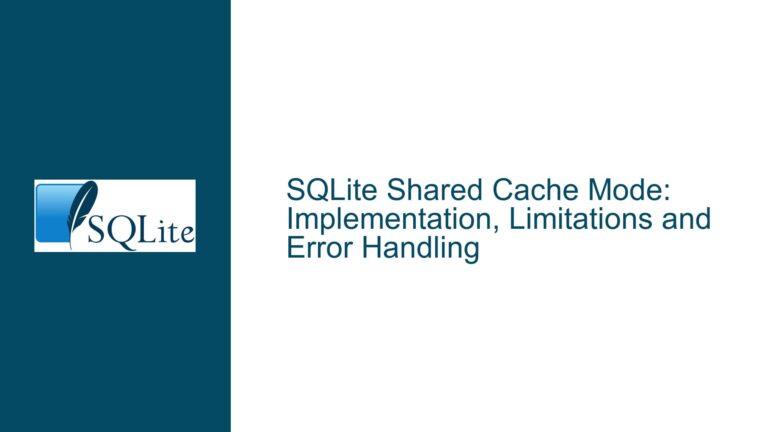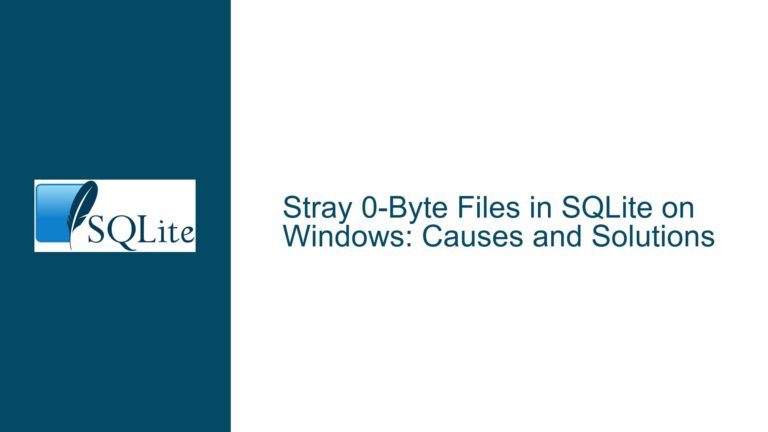Loading Cross-Origin SQLite WASM with COOP/COEP While Preserving CDN Assets
Understanding Cross-Origin Isolation Requirements for SQLite WASM and CDN Conflicts
The Core Challenge: Cross-Origin Isolation vs. Mixed-Origin Resource Loading
To use SQLite’s WebAssembly (WASM) module with the Origin Private File System (OPFS) persistence layer, browsers require Cross-Origin Isolation. This security measure is enforced via the Cross-Origin-Opener-Policy (COOP) and Cross-Origin-Embedder-Policy (COEP) HTTP headers. When these headers are set on a document (e.g., COOP: same-origin, COEP: require-corp), the browser restricts how the page interacts with cross-origin resources. Specifically, subresources (scripts, images, stylesheets) from other domains will be blocked unless they explicitly opt into being embedded via Cross-Origin Resource Sharing (CORS) or Cross-Origin Resource Policy (CORP).
The conflict arises when a website loads primary assets (JavaScript, CSS, images) from a Content Delivery Network (CDN) on a different domain. If the CDN-hosted assets lack CORS or CORP headers, enabling COOP/COEP for SQLite WASM breaks the loading of those CDN resources. The user’s goal is to enforce COOP/COEP only for SQLite-related assets (e.g., WASM binaries, Web Worker scripts) while allowing other CDN-hosted assets to load without modification.
Root Causes of Resource Blocking Under COOP/COEP Policies
1. Missing CORS Headers on Cross-Origin CDN Assets
CDN servers often lack CORS headers (Access-Control-Allow-Origin, Access-Control-Allow-Credentials) by default. When COEP is set to require-corp, the browser mandates that all cross-origin resources either:
- Belong to the same origin as the document,
- Include a
Cross-Origin-Resource-Policy: cross-originheader, or - Are fetched with a CORS-enabled request (using the
crossoriginattribute in HTML tags).
If CDN assets are served without these headers, the browser blocks them, causing broken layouts, missing scripts, or failed image loads.
2. Incorrect Use of the crossorigin Attribute in HTML Tags
Even if the CDN supports CORS, developers often omit the crossorigin attribute in <script>, <link>, or <img> tags. For example:
<!-- Missing crossorigin attribute -->
<script src="https://cdn.example/app.js"></script>
Without crossorigin="anonymous" or crossorigin="use-credentials", the browser treats the resource as a "no-CORS" request, which is incompatible with COEP’s require-corp policy.
3. Web Worker Initialization from Cross-Origin URLs
SQLite WASM often relies on Web Workers to offload database operations. Workers instantiated from cross-origin scripts require the worker script to be served with CORS headers and the crossorigin attribute in the worker constructor:
// Incorrect: Missing options for cross-origin workers
const worker = new Worker("https://sqlite-cdn.org/worker.js");
// Correct: Specifies CORS mode
const worker = new Worker("https://sqlite-cdn.org/worker.js", {
name: "sqlite-worker",
credentials: "same-origin", // or "omit"
});
If the worker script lacks CORS headers or the credentials option is misconfigured, worker initialization fails silently.
4. Mixed Security Contexts in Legacy CDN Configurations
Older CDNs may serve assets over HTTP or use invalid TLS certificates. COOP/COEP policies require a secure context (HTTPS with valid certificates), so mixed-content scenarios (HTTP resources on an HTTPS page) will block all insecure resources.
Resolving Conflicts Between COOP/COEP and Cross-Origin CDN Assets
Step 1: Audit CDN Assets for CORS and CORP Compatibility
Identify all cross-origin resources loaded by the page. Use browser developer tools (Network tab) to check for blocked requests. For each blocked resource, verify:
- The presence of CORS headers (
Access-Control-Allow-Origin: *or specific origins). - The presence of CORP headers (
Cross-Origin-Resource-Policy: cross-origin).
If the CDN supports CORS, proceed to Step 2. If not, contact the CDN provider to enable CORS or consider migrating to a CORS-enabled CDN.
Step 2: Add crossorigin Attributes to CDN Resource Tags
Modify HTML tags referencing CDN assets to include the crossorigin attribute. For public CDNs that support anonymous access:
<script src="https://cdn.example/app.js" crossorigin="anonymous"></script>
<link rel="stylesheet" href="https://cdn.example/styles.css" crossorigin="anonymous">
<img src="https://cdn.example/logo.png" crossorigin="anonymous">
For authenticated CDNs requiring cookies or credentials, use crossorigin="use-credentials" and ensure the CDN sends Access-Control-Allow-Credentials: true.
Step 3: Configure COOP/COEP Headers with Selective Enforcement
Set COOP/COEP headers only on the document (not on individual resources). For example:
Cross-Origin-Opener-Policy: same-origin
Cross-Origin-Embedder-Policy: require-corp
These headers apply to the entire page, but resources that comply with CORS/CORP will load, while non-compliant ones are blocked.
Step 4: Host SQLite WASM Assets on a CORS-Enabled Endpoint
Ensure SQLite’s WASM files (e.g., sqlite3.wasm, worker.js) are served from a domain that includes:
Access-Control-Allow-Origin: *or the requesting origin.Cross-Origin-Resource-Policy: cross-origin(optional but recommended).
If using a third-party CDN for SQLite assets, confirm they send these headers. If self-hosting, configure the server (e.g., Apache, Nginx) to include them.
Step 5: Initialize Web Workers with CORS Parameters
When creating a Web Worker for SQLite, explicitly set the credentials option to match the resource’s CORS configuration:
// For public CDNs with Access-Control-Allow-Origin: *
const worker = new Worker("https://sqlite-cdn.org/worker.js", {
credentials: "omit",
});
// For authenticated endpoints requiring cookies
const worker = new Worker("https://sqlite-cdn.org/worker.js", {
credentials: "include",
});
Step 6: Use a Proxy Server for Non-Compliant CDN Assets
If the CDN cannot be modified to support CORS/CORP, route asset requests through a same-origin proxy server. Configure the proxy to:
- Fetch resources from the CDN.
- Add CORS headers (
Access-Control-Allow-Origin: *) to the response. - Serve the resources under the same origin as the main page.
Example Nginx proxy configuration:
location /proxy/ {
proxy_pass https://cdn.example/;
add_header Access-Control-Allow-Origin "*";
add_header Cross-Origin-Resource-Policy "cross-origin";
}
Update HTML tags to use the proxy URL:
<script src="/proxy/app.js"></script>
Step 7: Validate Security Headers with Automated Tools
Use tools like SecurityHeaders.com or browser consoles to verify:
- COOP/COEP headers are present on the main document.
- All subresources either pass CORS checks or are same-origin.
Step 8: Graceful Degradation for Blocked Resources
Implement fallbacks for critical assets that cannot be made CORS-compliant. For example:
window.addEventListener("error", (e) => {
if (e.target.tagName === "SCRIPT" && !e.target.crossOrigin) {
const fallbackScript = document.createElement("script");
fallbackScript.src = "/local-fallback.js";
document.body.appendChild(fallbackScript);
}
}, true);
Step 9: Monitor and Update CDN Configurations
CDN providers occasionally update their CORS policies. Periodically re-audit assets using curl or Postman:
curl -I -H "Origin: https://your-domain.com" https://cdn.example/app.js
Look for Access-Control-Allow-Origin in the response headers.
By methodically auditing cross-origin resources, enforcing CORS compliance, and leveraging proxy servers where necessary, developers can successfully enable Cross-Origin Isolation for SQLite WASM while maintaining compatibility with existing CDN-hosted assets.






